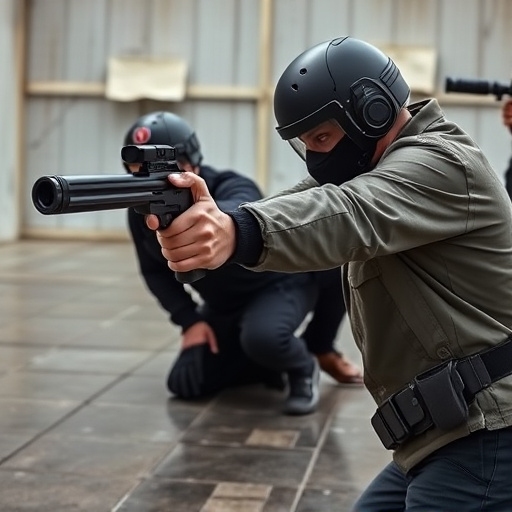Military-grade pepper spray formulas, potent capsaicin-based agents, are crucial for crowd control, offering a non-lethal option for law enforcement. With varying concentrations and advanced features like enhanced visibility, they ensure public safety during protests, riots, and high-traffic events. However, their use sparks debates about legal boundaries, ethical considerations, and proportionality, leading to regulatory trends worldwide.
In today’s diverse and often unpredictable social landscapes, police forces worldwide increasingly rely on military-grade pepper spray as a crowd control measure. This potent tool, with its unique formula compositions, offers both advantages and complexities in law enforcement. Our comprehensive guide delves into the world of pepper spray, exploring its effectiveness, safety protocols, global legal frameworks, and the ethical considerations surrounding its use. We dissect various formulas, shedding light on their composition and impact, providing an indispensable resource for understanding this controversial yet necessary tool.
- Military Grade Pepper Spray: Powerful Tools
- Crowd Control Tactics: When and Why Used
- Formulas Revealed: Composition & Effectiveness
- Safety & Training: Responsible Application
- Global Perspective: Legal and Ethical Considerations
Military Grade Pepper Spray: Powerful Tools
Military-grade pepper spray formulations are designed to be potent and effective tools in crowd control scenarios. These sprays utilize capsaicin, the active ingredient found in chili peppers, which irritates the eyes, nose, and respiratory system, temporarily disabling individuals and allowing for safer control of large gatherings. The strength of military-grade pepper spray is typically much higher than commercial varieties, making it a powerful resource for law enforcement to manage violent or unruly crowds effectively.
Formulas differ in terms of concentration, with higher percentages of capsaicin offering longer durations of effect. Some advanced formulations also incorporate additional agents to enhance visibility during night operations or to mitigate the effects of pepper spray on individuals with respiratory conditions. These tactical considerations ensure that law enforcement agencies have access to a versatile and reliable tool, crucial for maintaining public safety in various environments, from high-traffic events to potential riot situations.
Crowd Control Tactics: When and Why Used
Crowd control tactics, including the deployment of military-grade pepper spray formulas, are essential tools for law enforcement agencies to maintain public safety and order during various events and situations. These non-lethal methods are strategically employed when traditional policing approaches may not be effective or could escalate tensions. Pepper spray, in particular, has become a prevalent choice due to its ability to quickly disable individuals without causing permanent harm.
When used appropriately, military-grade pepper spray formulas can disrupt crowd dynamics and allow officers to regain control. The powerful yet controlled release of capsaicin, the active ingredient, irritates the eyes, nose, and respiratory system, temporarily disorienting those affected. This tactic is often employed in high-risk scenarios such as large-scale protests, riots, or when dealing with resistant individuals who pose a threat to public security. Effective crowd control measures ensure that law enforcement can manage situations swiftly and minimize potential injuries while maintaining the peace.
Formulas Revealed: Composition & Effectiveness
Military-grade pepper spray formulas have been meticulously designed and refined over decades, combining potent capsaicinoids with other active ingredients to create powerful agents for crowd control. The primary component, capsaicin, is responsible for the burning sensation it induces when exposed to mucous membranes. These formulations often include additives like synthetic analogs, which enhance its irritant properties and extend its duration, making it effective at controlling and dispersing large groups of individuals quickly and safely.
Safety & Training: Responsible Application
Police officers are equipped with military-grade pepper spray formulas as a crucial tool for crowd control, designed to incapacitate individuals temporarily while ensuring officer and public safety. The responsible application of this powerful agent requires rigorous training, emphasizing technique and de-escalation strategies. Well-trained officers can accurately target specific areas, minimizing the impact on bystanders and reducing the risk of excessive force.
This specialized training involves learning the appropriate distance, spray patterns, and duration for optimal effect while maintaining a safe distance from both the target and innocent observers. Additionally, officers are taught to monitor the environment, considering factors like wind direction and crowd dynamics to prevent the spray from dispersing uncontrollably. Such meticulous training underscores the importance of tactical pepper spray as a safe and effective method of crowd control when used by trained professionals.
Global Perspective: Legal and Ethical Considerations
Around the globe, the deployment of military-grade pepper spray formulas by law enforcement agencies for crowd control has sparked debates surrounding legal and ethical boundaries. While many countries recognize its potential to de-escalate volatile situations and ensure officer safety, human rights activists and civil liberties groups express concern over its misuse and the potential for excessive force. The use of pepper spray often raises questions about proportionality, consent, and the appropriate circumstances under which it should be employed.
Internationally, there’s a growing trend towards regulating and restricting the use of chemical agents like pepper spray. Some jurisdictions have implemented strict guidelines governing their deployment, mandating the use of less-lethal options before resorting to them, and requiring independent oversight for incidents involving their use. These global perspectives reflect a nuanced understanding that while military-grade pepper spray formulas can be effective tools in crowd control, they must be used responsibly and ethically to uphold the rights and dignity of citizens.
Military-grade pepper spray is a potent crowd control tool, but its use requires careful consideration of safety and ethical implications. Understanding the intricate formulas behind these sprays, as revealed in this article, highlights the importance of responsible application. While essential for certain high-risk scenarios, it’s crucial to balance its effectiveness with the need for minimal harm, especially when navigating global legal and ethical frameworks. By adhering to strict training protocols, authorities can ensure public safety without unnecessarily infringing upon civil liberties.
